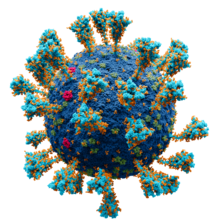
Медицина — это наука и практика ухода за пациентами, управления диагностикой , прогнозированием , профилактикой , лечением , паллиативным лечением их травм или заболеваний и укрепления их здоровья . Медицина охватывает различные практики здравоохранения , разработанные для поддержания и восстановления здоровья путем профилактики и лечения заболеваний . Современная медицина применяет биомедицинские науки , биомедицинские исследования , генетику и медицинские технологии для диагностики , лечения и предотвращения травм и заболеваний, как правило, с помощью фармацевтических препаратов или хирургии , но также с помощью таких разнообразных методов лечения, как психотерапия , внешние шины и вытяжение , медицинские устройства , биологические препараты и ионизирующее излучение , среди прочего.
Медицина практикуется с доисторических времен , и большую часть этого времени это было искусство (область творчества и мастерства), часто связанное с религиозными и философскими верованиями местной культуры. Например, знахарь применял травы и читал молитвы об исцелении, или древний философ и врач применял кровопускание в соответствии с теориями гуморизма . В последние столетия, с появлением современной науки , большая часть медицины стала сочетанием искусства и науки (как базовой , так и прикладной , под эгидой медицинской науки ) . Например, в то время как техника наложения швов является искусством, изучаемым на практике, знание того, что происходит на клеточном и молекулярном уровне в сшиваемых тканях, возникает благодаря науке.
Донаучные формы медицины, теперь известные как традиционная медицина или народная медицина , остаются широко используемыми в отсутствие научной медицины и поэтому называются альтернативной медициной . Альтернативные методы лечения вне научной медицины с этическими, безопасными и эффективными проблемами называются шарлатанством . ( Полная статья... )







Присоединяйтесь к WikiProject Medicine . Мы обсуждаем сотрудничество и всевозможные вопросы на нашей странице обсуждения .





Более подробную информацию по этой теме можно найти в следующих родственных проектах Фонда Викимедиа :